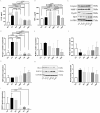Exercise Attenuate Diaphragm Atrophy in COPD Mice via Inhibiting the RhoA/ROCK Signaling
- PMID: 39005647
- PMCID: PMC11244622
- DOI: 10.2147/COPD.S460182
Exercise Attenuate Diaphragm Atrophy in COPD Mice via Inhibiting the RhoA/ROCK Signaling
Abstract
Background: Exercise is an indispensable component of pulmonary rehabilitation with strong anti-inflammatory effects. However, the mechanisms by which exercise prevents diaphragmatic atrophy in COPD (chronic obstructive pulmonary disease) remain unclear.
Methods: Forty male C57BL/6 mice were assigned to the control (n=16) and smoke (n=24) groups. Mice in the smoke group were exposed to the cigarette smoke (CS) for six months. They were then divided into model and exercise training groups for 2 months. Histological changes were observed in lung and diaphragms. Subsequently, agonist U46639 and antagonist Y27632 of RhoA/ROCK were subjected to mechanical stretching in LPS-treated C2C12 myoblasts. The expression levels of Atrogin-1, MuRF-1, MyoD, Myf5, IL-1β, TNF-α, and RhoA/ROCK were determined by Western blotting.
Results: Diaphragmatic atrophy and increased RhoA/ROCK expression were observed in COPD mice. Exercise training attenuated diaphragmatic atrophy, decreased the expression of MuRF-1, and increased MyoD expression in COPD diaphragms. Exercise also affects the upregulation of RhoA/ROCK and inflammation-related proteins. In in vitro experiments with C2C12 myoblasts, LPS remarkably increased the level of inflammation and protein degradation, whereas Y27632 or combined with mechanical stretching prevented this phenomenon considerably.
Conclusion: RhoA/ROCK plays an important role in the prevention of diaphragmatic atrophy in COPD.
Keywords: RhoA/ROCK signaling; chronic obstructive pulmonary disease; diaphragmatic atrophy; exercise training; inflammation.
© 2024 Li et al.
Conflict of interest statement
The authors declare that they have no conflicts of interest in this work.
Figures





Similar articles
-
Reduced nuclear translocation of serum response factor is associated with skeletal muscle atrophy in a cigarette smoke-induced mouse model of COPD.Int J Chron Obstruct Pulmon Dis. 2017 Feb 20;12:581-587. doi: 10.2147/COPD.S109243. eCollection 2017. Int J Chron Obstruct Pulmon Dis. 2017. PMID: 28260872 Free PMC article.
-
RANKL Mediates Muscle Atrophy and Dysfunction in a Cigarette Smoke-induced Model of Chronic Obstructive Pulmonary Disease.Am J Respir Cell Mol Biol. 2021 May;64(5):617-628. doi: 10.1165/rcmb.2020-0449OC. Am J Respir Cell Mol Biol. 2021. PMID: 33689672
-
Aerobic exercise training engages the canonical wnt pathway to improve pulmonary function and inflammation in COPD.BMC Pulm Med. 2024 May 14;24(1):236. doi: 10.1186/s12890-024-03048-z. BMC Pulm Med. 2024. PMID: 38745304 Free PMC article.
-
RhoA-ROCK Signaling as a Therapeutic Target in Traumatic Brain Injury.Cells. 2020 Jan 18;9(1):245. doi: 10.3390/cells9010245. Cells. 2020. PMID: 31963704 Free PMC article. Review.
-
Diaphragm Dysfunction and Rehabilitation Strategy in Patients With Chronic Obstructive Pulmonary Disease.Front Physiol. 2022 May 2;13:872277. doi: 10.3389/fphys.2022.872277. eCollection 2022. Front Physiol. 2022. PMID: 35586711 Free PMC article. Review.
References
-
- Global initiative for chronic obstructive lung disease; Global strategy for the diagnosis, management, and prevention of chronic obstructive pulmonary disease (2023 report). Available from: https://goldcopd.org/. Accessed July 2, 2024.
-
- Lin H, Sun Sh, Gao J, et al. The influence of indomethacin on TNFα and skeletal muscle protein catabolism in chronic obstructive pulmonary disease rat model. Zhonghua nei ke za zhi. 2010;49(9):776–780. - PubMed
MeSH terms
Substances
LinkOut - more resources
Full Text Sources
Medical

